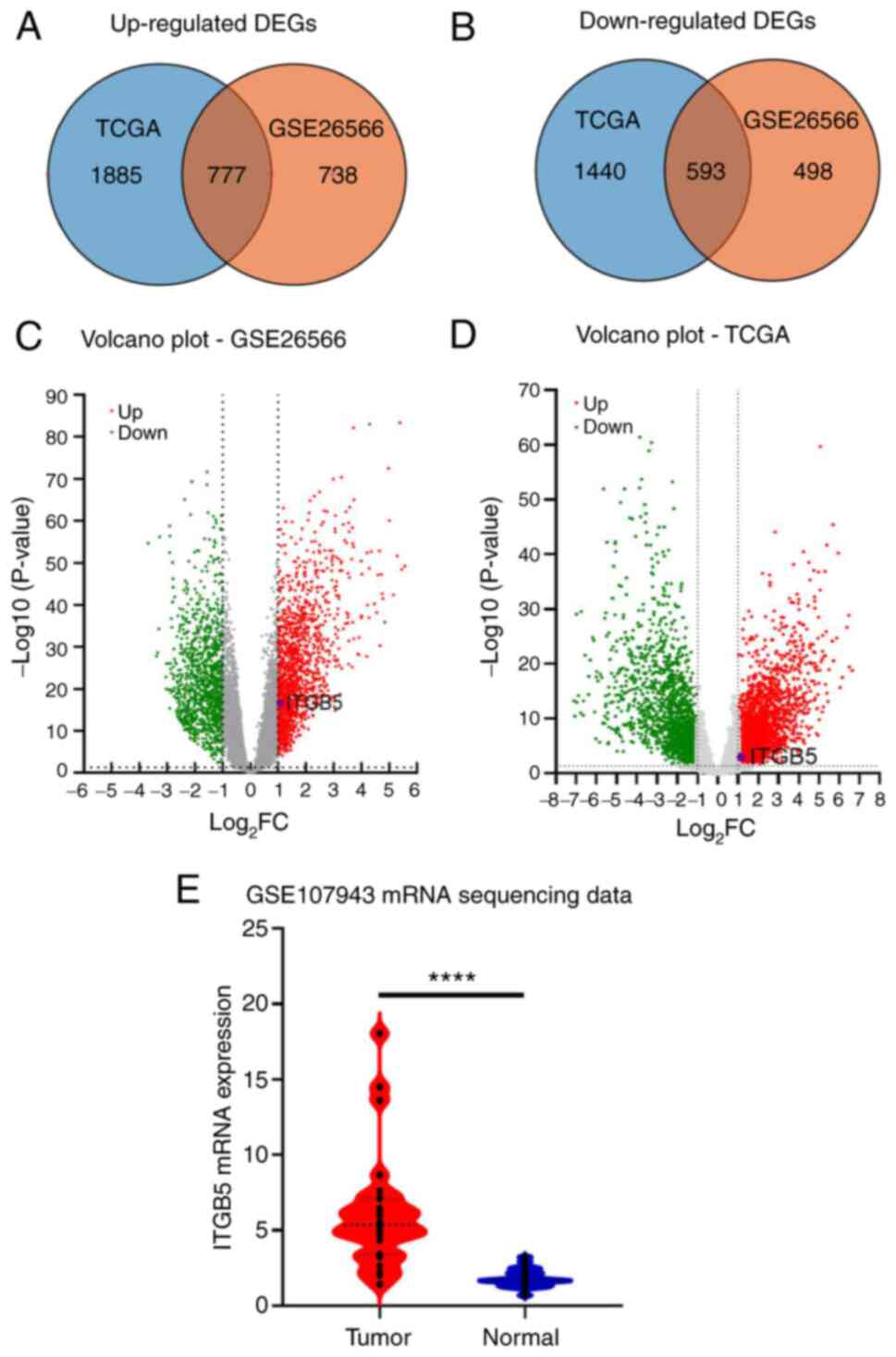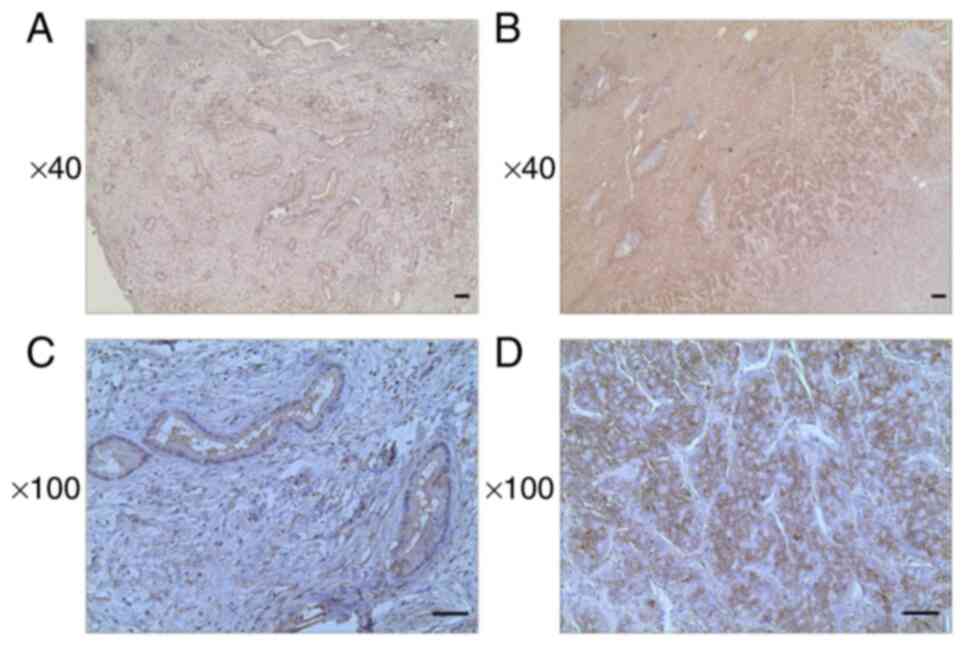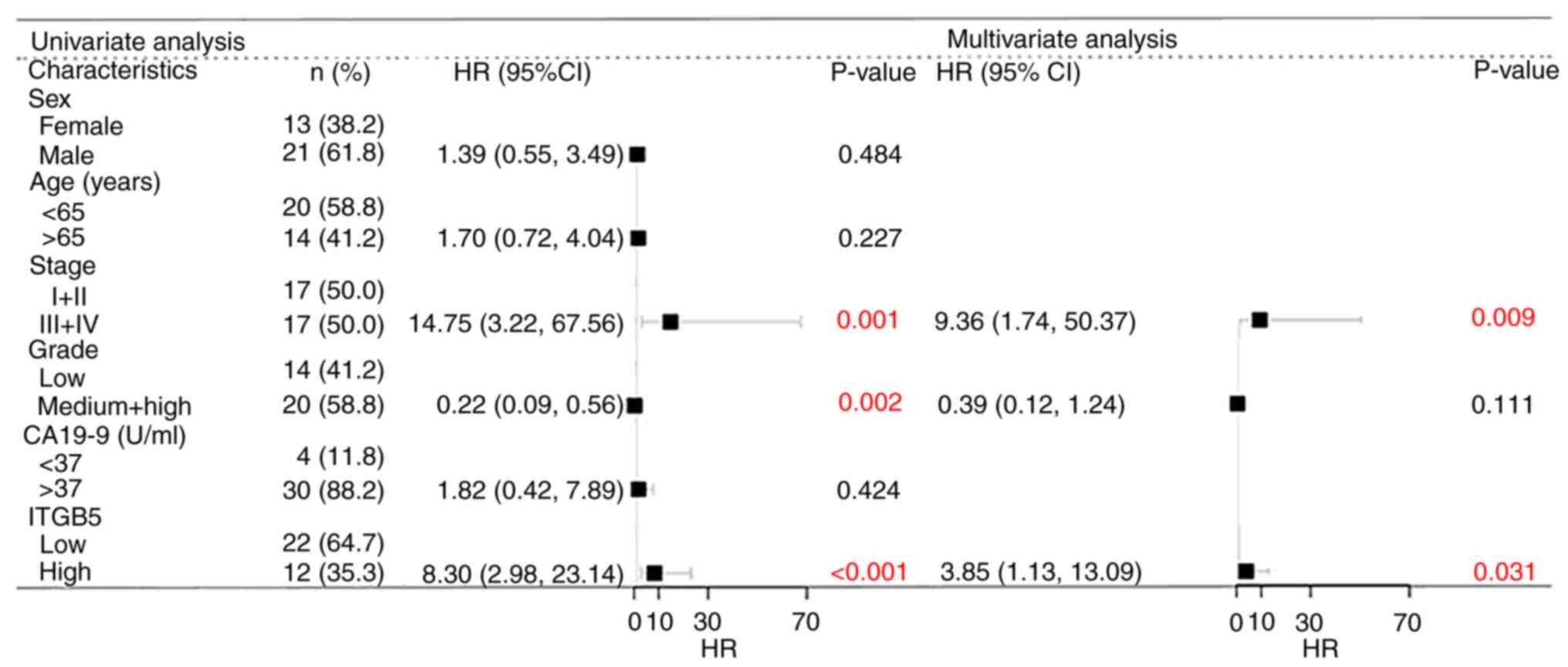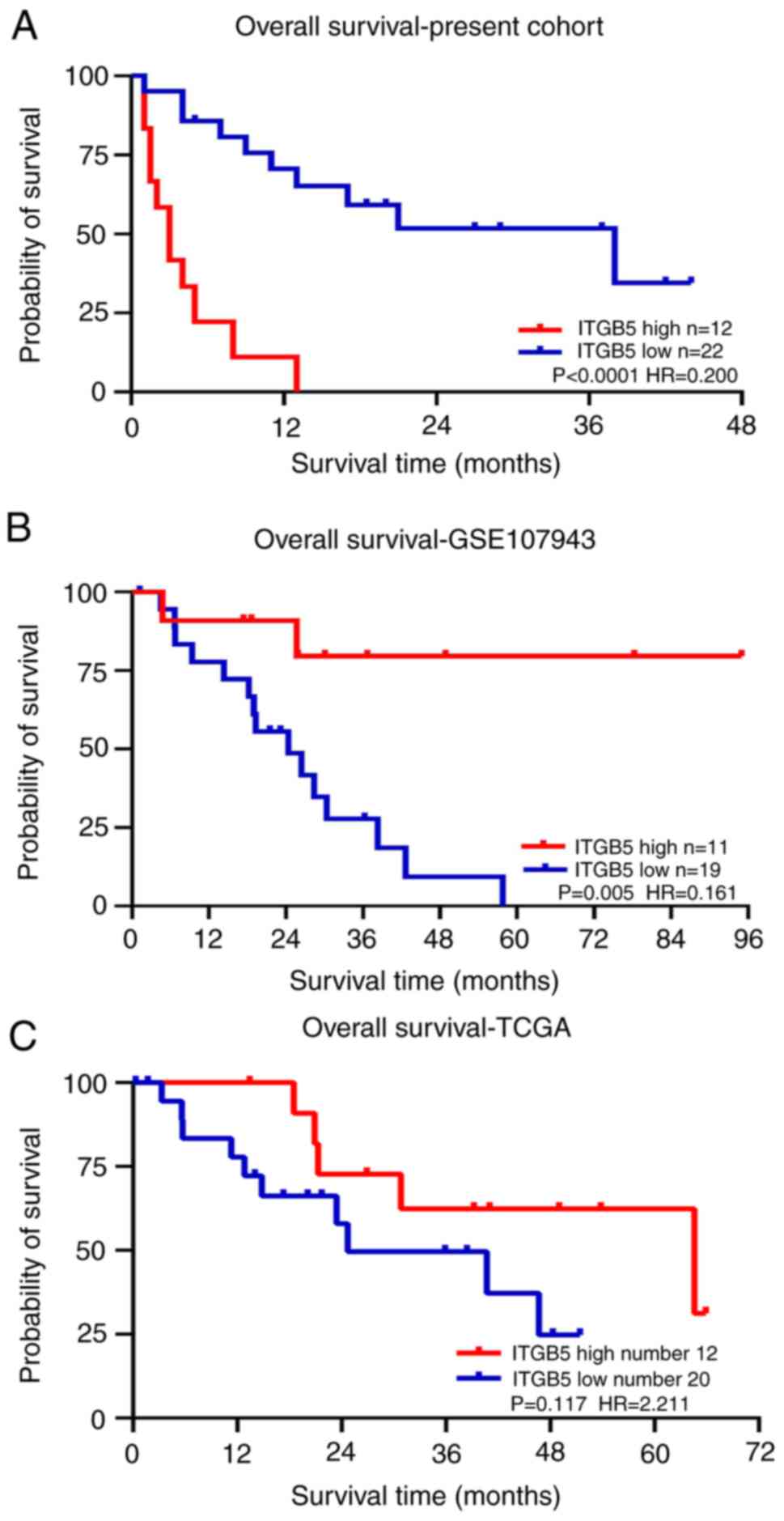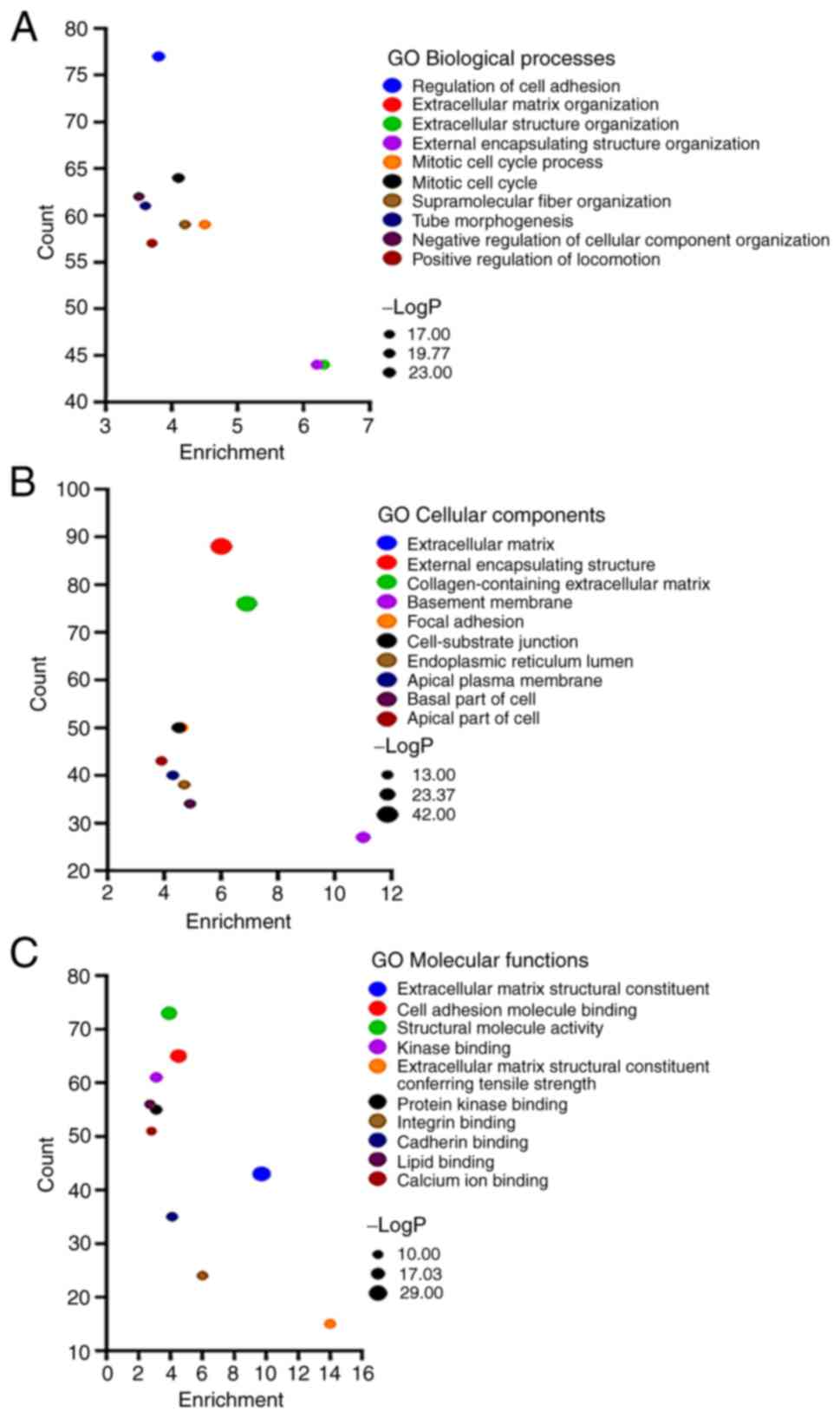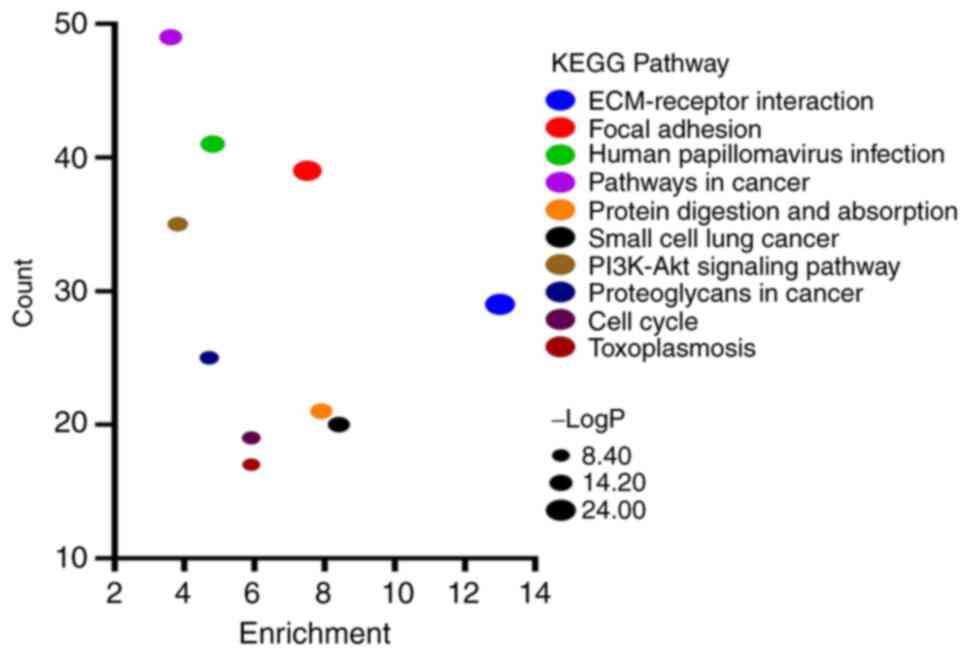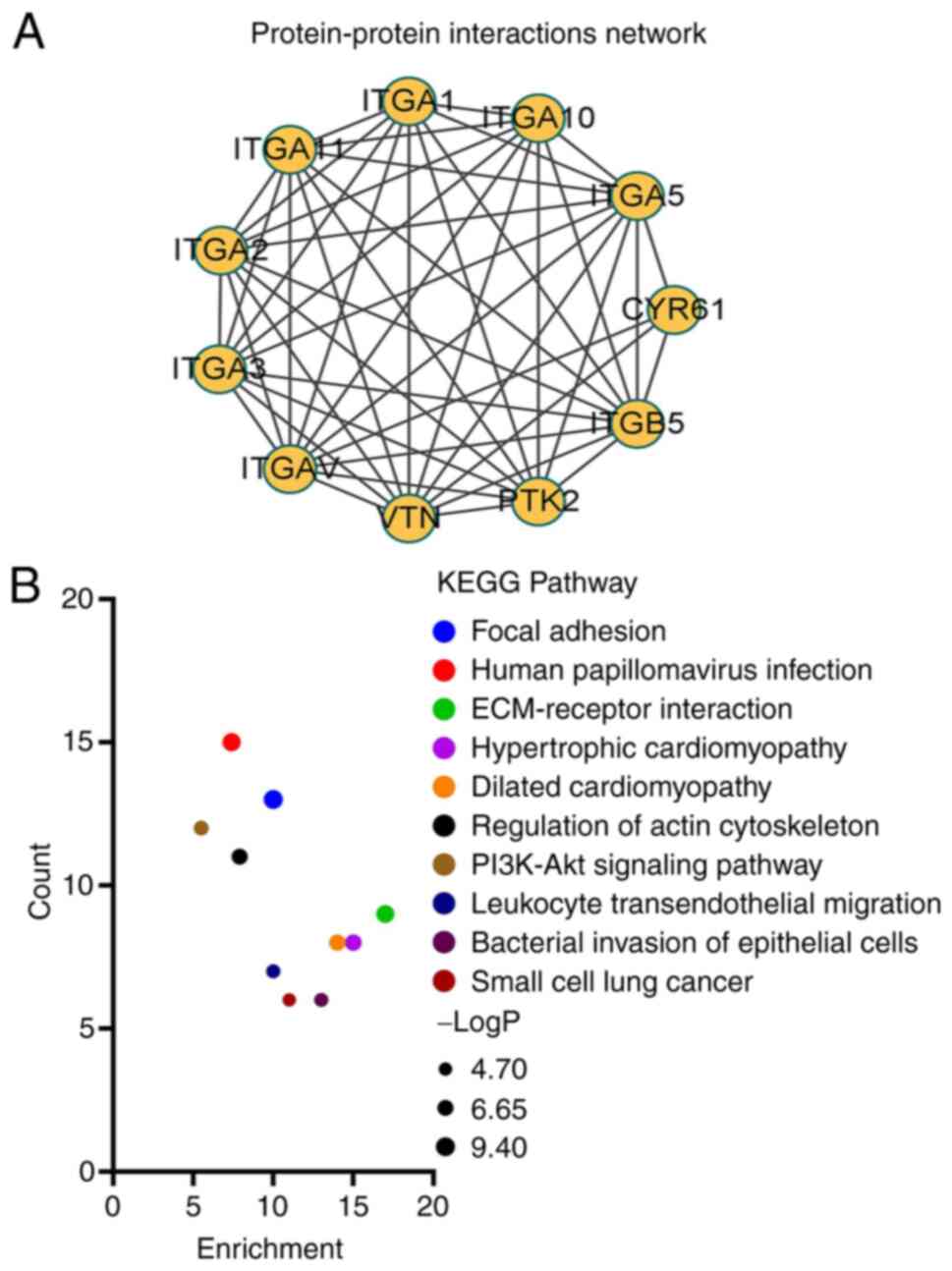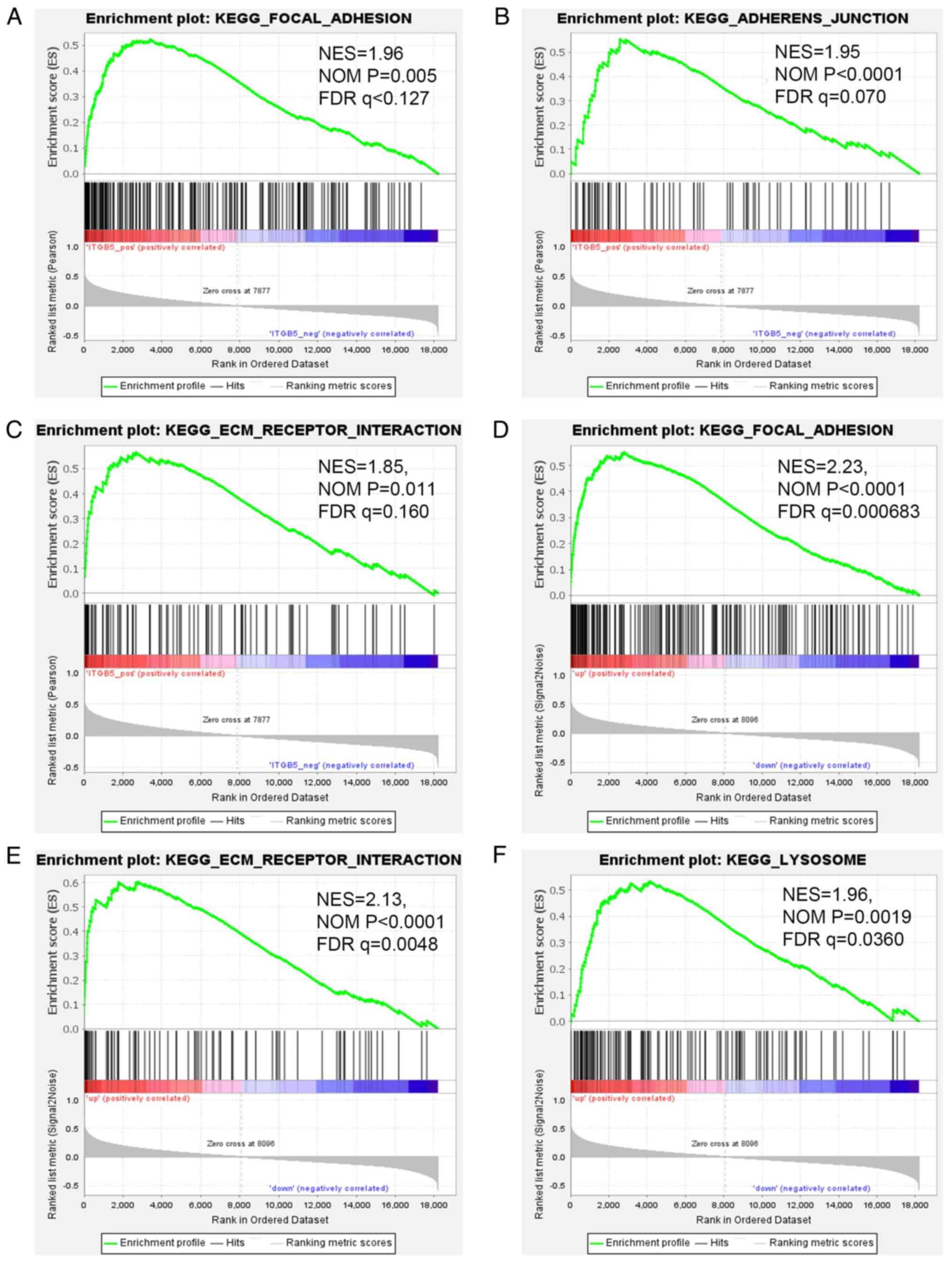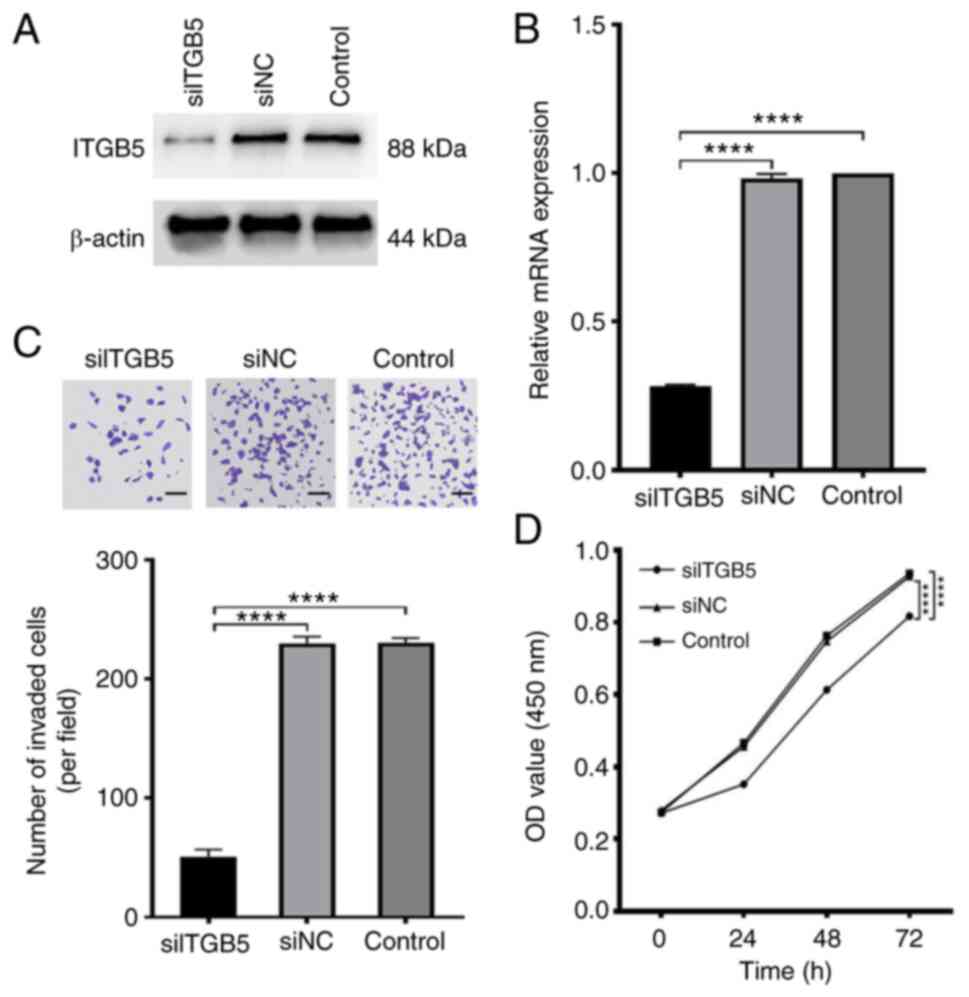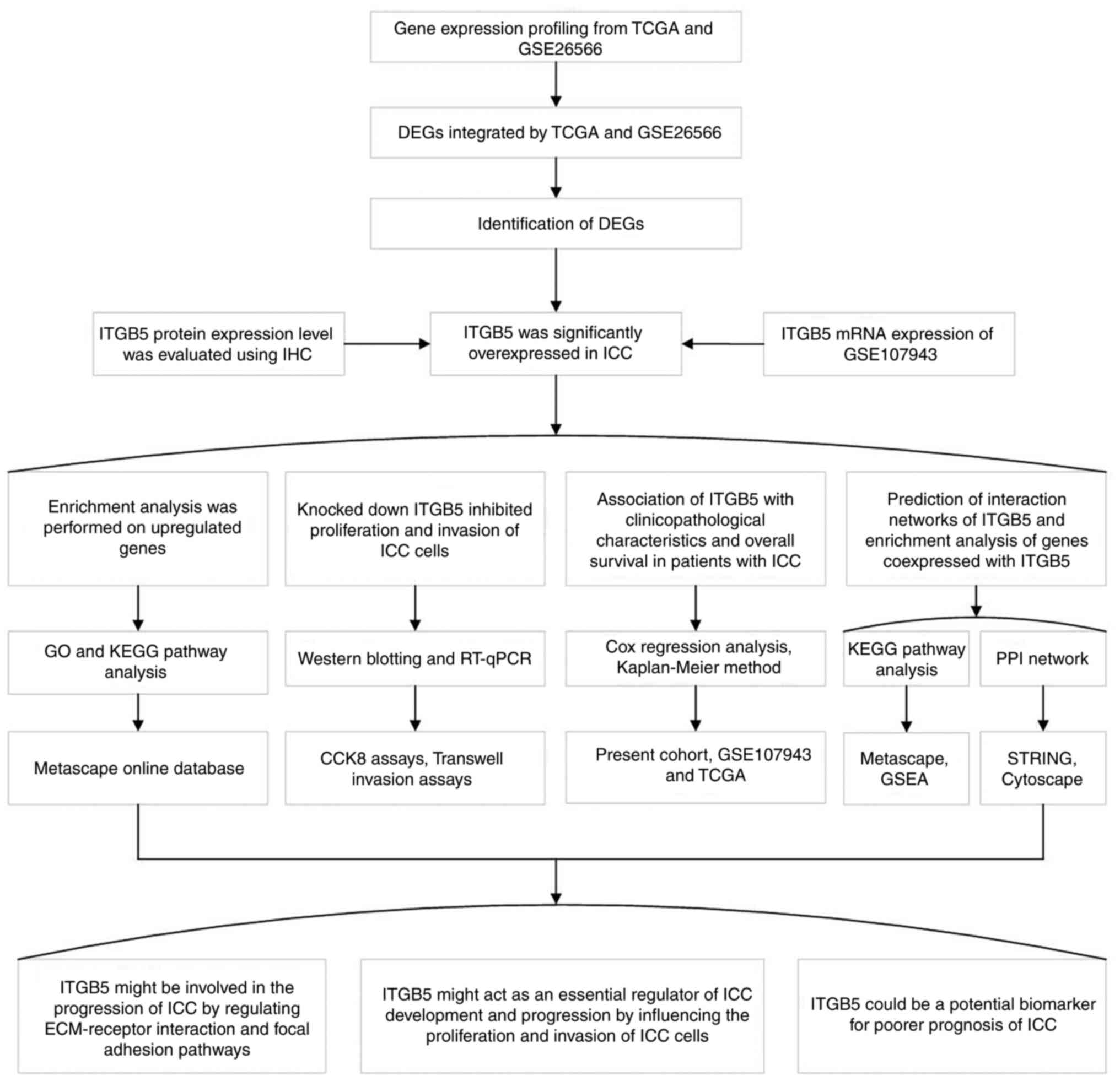Integrin β5 is an independent prognostic marker for intrahepatic cholangiocarcinoma in a Chinese population
- Authors:
- Published online on: September 28, 2023 https://doi.org/10.3892/etm.2023.12231
- Article Number: 532
-
Copyright: © Ma et al. This is an open access article distributed under the terms of Creative Commons Attribution License.
Abstract
Introduction
Intrahepatic cholangiocarcinoma (ICC) is a rare (0.79 cases per 100,000 individuals) but often fatal malignancy originating from the epithelium of the secondary bile duct and its branches (1,2). ICC is the second most common primary liver malignancy after hepatocellular carcinoma (HCC), and the incidence of ICC has increased globally over the last decades, whereas the incidence of perihilar cholangiocarcinoma and distal cholangiocarcinoma has decreased (3-8). Some of these changes are attributable to the alterations in disease classification, or to the more advanced diagnostic modalities that may identify early lesions and biliary malignancies that were previously undiagnosed (2). Furthermore, the increasing incidence of ICC may be associated with certain newly recognized strong risk factors, such as viral hepatitis, non-specific cirrhosis, nonviral chronic liver diseases and metabolic diseases (9). Due to the rarity, early metastasis and unclear symptoms of early ICC, only 10-15% of patients can undergo radical resection (10,11). The median overall survival (OS) of patients with ICC is 12-18 months, with the 5-year OS being rates <5% (12,13). Thus, it is necessary to elucidate the precise molecular mechanisms of ICC pathogenesis for predicting prognosis.
Integrins are a group of integral transmembrane heterodimers with numerous functions, including cell adhesion in the extracellular matrix (ECM) and acting as receptors for recognizing Arg-Gly-Asp (RGD) peptide motifs, laminin, snake venoms, viruses and other pathogens (14-17). Given the roles of integrins in multiple fundamental biological processes, the aberrant expression of integrin family members is linked to the prognosis of various types of cancer, including gastric cancer (18), breast cancer (19), pancreatic carcinoma (20) and colorectal cancer (21).
Integrin β5 (ITGB5), which associates with integrin αV (22), has been indicated to facilitate cancer cell migration, invasion and transforming growth factor β (TGF-β)-induced epithelial-mesenchymal transition (23). Lin et al (24) reported that ITGB5 promoted tumorigenesis in HCC by interacting with β-catenin. Furthermore, Wortzel et al (25) revealed that ITGB5 was enriched in liver metastatic pancreatic cancer exosomes. ITGB5 is a potential independent prognostic biomarker and therapeutic target for hepatitis B virus (HBV)-related HCC and may be useful for its diagnosis (26). These studies have indicated the potential role of ITGB5 in intercellular communication during tumor progression and metastasis. However, the role of ITGB5 in ICC remains largely unknown. The aim of the present study was to investigate the ITGB5 expression levels in ICC tissues and to examine whether the expression level of ITGB5 was associated with the prognosis of patients with ICC.
Materials and methods
Data processing of acquisition and identification of differentially expressed genes (DEGs)
Microarray data for ICC were obtained from the Gene Expression Omnibus (GEO) database (https://www.ncbi.nlm.nih.gov/geo/). Two expression profiling datasets, GSE26566(27) and GSE107943(28), were obtained. The GSE26566 dataset contained 104 ICC samples and 6 normal samples. The GSE107943 dataset contained 30 ICC samples and 27 normal samples, as well as clinicopathological information regarding the tumor samples. All expression profiles were downloaded and processed using the R package of GEOquery (29). The transcriptome profiles of 32 ICC samples and 9 normal samples and clinical information of tumor samples were obtained from The Cancer Genome Atlas (TCGA) database (https://cancergenome.nih.gov/) and analyzed using the R package of TCGAbiolinks (30). The GSE26566 and TCGA datasets were analyzed separately as volcano maps using GraphPad Prism 9 (GraphPad Software; Dotmatics). Log2 fold-change (FC)>1 and P<0.05 were defined as the screening thresholds. Common DEGs of the GSE26566 and TCGA datasets were obtained through the TBtools (31). For the definition of high or low expression levels of ITGB5 in the GSE107943 and TCGA datasets, the expression of ITGB5 was divided into two groups according to the survival status of patients with ICC, and separate receiver operating characteristic curves were obtained to determine the ITGB5 cut-off value with area under the curve >0.8 and P<0.05.
Patient tissues
The present retrospective study on patient tissues and data was approved by the Medical Ethics Committee of Taizhou People's Hospital (approval no. KY 2020-091-01), and was conducted according to the Declaration of Helsinki. Written informed consent was received from each patient at the time of surgery. Surgical resection for ICC was used to treat 34 patients in Taizhou People's Hospital (Taizhou, China) between January 2014 and December 2020 (Table I). All specimens were obtained from the Department of Pathology of Taizhou People's Hospital, and were histologically diagnosed in accordance with the World Health Organization criteria (32). Clinical features were extracted from patient medical records. Tumor stages were classified according to the 8th American Joint Cancer Committee tumor-node-metastasis (TNM) classification (stages I-IV) (33).
Gene function enrichment analysis
Gene Ontology (GO) is widely used in bioinformatics, and covers three aspects of biology, namely biological processes, molecular functions and cellular components (34). Kyoto Encyclopedia of Genes and Genomes (KEGG) is a set of high-throughput genes and protein pathways (35). Metascape is an online analysis tool suite with the function of annotations and analyses (36). GO and KEGG pathway enrichment analyses were performed for the upregulated DEGs using Metascape analysis. All significant GO and KEGG enrichment results were visualized with the bubble chart of GraphPad Prism 9 (GraphPad Software; Dotmatics).
Protein-protein interaction (PPI) network and functional annotations of ITGB5
The Search Tool for the Retrieval of Interacting Genes/Proteins (STRING) online database (http://string-db.org) could predict and trace out the PPI network. The top 10 interacting genes associated with ITGB5 were obtained using STRING. Cytoscape version 3.9.0, a free visualization software, was used to visualize the PPI network (37). The 210 genes interacting with ITGB5, as determined using the STRING online database (10 genes) and Gene Expression Profiling Interactive Analysis of GEPIA (38) (200 genes), were all inputted into the Metascape (36) for further functional annotations and analyses. Gene Set Enrichment Analysis (GSEA) version 4.2.3(39), a free gene analysis software, was used to reveal the functional pathways of ITGB5 in ICC, using transcriptional data from the GSE26566 dataset. A 1,000 permutation test, nominal (NOM) P<0.05 and false discovery rate (FDR) q<0.25 were used as the screening criteria to identify the most significantly involved pathways. Patients were divided into two groups according to the median ITGB5 mRNA expression level. GSEA was performed to determine whether the identified sets of genes exhibited significant differences between the two groups based on the normalized enrichment score (NES) and FDR. Based on correlation coefficients, pathway analysis associated with ITGB5 using GSEA was implemented. The aforementioned three methods were validated against each other to determine the most relevant pathway.
Cell lines and culture
Human cholangiocarcinoma HuCCT1 cells were purchased from the Shanghai Cell Bank of The Chinese Academy of Science. Cells were cultured in Dulbecco's Modified Eagle's Medium (DMEM) (Gibco; Thermo Fisher Scientific, Inc.) supplemented with 10% fetal bovine serum (FBS) (Invitrogen; Thermo Fisher Scientific, Inc.), 100 U/ml penicillin and 100 µg/ml streptomycin. Cells were maintained at 37˚C in a humidified environment containing 5% CO2.
Immunohistochemical (IHC) staining
Paraffin-embedded sections of tissues were deparaffinized, hydrated and incubated with 0.3% hydrogen peroxide to block endogenous peroxidase. Microwave heating (microwave oven for 30 min at 250 W) was used for antigen retrieval. The sections were first incubated in a 2% bovine serum albumin buffer (Sigma-Aldrich; Merck KGaA) at 37˚C for 30 min and then at 4˚C overnight with anti-ITGB5 rabbit polyclonal antibody (1:100; cat. no. ab15459; Abcam). For the antibody binding, The sections were then washed three times with 0.5% Tween, 0.1 M Tris-base, 0.9% NaCl, (TBS-T; pH 7.6) for 5 min each wash and incubated in biotinylated goat anti-rabbit IgG (1:100; cat. no. ab172730; Abcam) at 37˚C for 30 min. Positive reactions were visualized using diaminobenzidine solution followed by counterstaining with hematoxylin at room temperature for 8 min. Tissue sections were observed using an AX10-Imager A1 light microscope (Zeiss GmbH), and all images were captured using AxioVision microscopy software (version 4.7; Zeiss GmbH). All IHC staining was independently evaluated by two experienced gastrointestinal pathologists. IHC scores were calculated by multiplying the intensity of staining (0: Negative; 1: Light yellow; 2: Yellowish brown; and 3: Brown) by the percentage of positive cells (1: <5%; 2: 6-25%; 3: 26-70%; and 4: >70%), and finally interpreted as high or low expression levels. If the final score was ≥4, the ITGB5 expression level was considered high; otherwise, it was considered low.
Western blot analysis
Whole-cell lysates were prepared by lysing HuCCT1 (2x106 cells/ml) pellets in RIPA lysis buffer. Following centrifugation at 1,000 x g for 30 min at 4˚C to remove all debris, and the protein levels were estimated using a Super-Bradford Protein Assay kit (CoWin Biosciences Co., Ltd.), according to the manufacturer's protocol. Each 40-µg aliquot of total protein was loaded on a 10% SDS-PAGE gel (25 µg) and separated at 100 V for 1.5 h. After electrophoresis, the proteins were transferred onto PVDF membranes (EMD Millipore) and then blocked with 5% skimmed milk for 60 min at room temperature. After washing with TBST three times, membranes were co-incubated with the primary antibodies against ITGB5 (1:500 dilution; cat. no. ab184312) and β-actin (1:1,000 dilution; cat. no. ab115777; both from Abcam) overnight at 4˚C in TBST. After incubation with horseradish peroxidase-conjugated goat anti-rabbit immunoglobulin G (1:5,000 dilution; cat. no. BA1055; Beyotime Institute of Biotechnology) in TBST at room temperature for 60 min, bands were detected using BeyoECL Plus (Beyotime Institute of Biotechnology) and captured using an Image Quant LAS-4000 (FUJIFILM Wako Pure Chemical Corporation). The expression of ITGB5 protein was normalized to β-actin expression.
Reverse transcription-quantitative PCR (RT-qPCR)
Total RNA from harvested cells was extracted using an RNA isolation kit with genomic DNA filter columns (BioTeke Corporation) according to the manufacturer's protocol. After RNA quantification and quality control using spectrophotometry with the optical density (OD) OD260/OD280 ratio controlled at 1.8-2.0, RNA samples were reverse transcribed into cDNA using a reverse transcriptase kit (Takara Biotechnology Co., Ltd.), followed by PCR with SYBR® Green RT-PCR Master mix (Takara Bio, Inc.) according to the manufacturer's protocols. The relative levels of target gene mRNA transcripts to the control β-actin in individual samples were determined in an ABI PRISM 7000 Sequence Detection System (Applied Biosystems; Thermo Fisher Scientific, Inc.) under the following thermocycling conditions: 50˚C for 2 min, 9˚C for 10 min, 40 cycles at 95˚C for 15 sec and 60˚C for 1 min. Data were normalized to the control β-actin and analyzed using the 2-ΔΔCq method (40). Samples were assayed in triplicate in three independent experiments. The primers for the amplification of the indicated genes were as follows: ITGB5, forward 5'-ACCTGGAACAACGGTGGAGA-3' and reverse 5'-AAAAGATGCCGTGTCCCCAA-3'; and β-actin, forward 5'-CAAGAGATGGCCACGGCTGCT-3' and reverse 5'-TCCTTCTGCATCCTGTCGGCA-3'.
Small interfering RNA (siRNA) transfection
siRNA against ITGB5 and a negative control siRNA were designed and synthesized by Shanghai GenePharma Co., Ltd. HuCCT1 cells were transfected with siRNA (800 µg/ml) using Lipofectamine® 3000 (Invitrogen; Thermo Fisher Scientific, Inc.). Cells were plated in six-well plates at a density of 2x106 cells/well. Lipofectamine® 3000 and siRNA were mixed together in Opti-MEM (Invitrogen; Thermo Fisher Scientific, Inc.). The cell culture medium was replaced with Opti-MEM at 37˚C for 6 h. The cells were cultured in normal medium for 48 h before the subsequent experiments. The ITGB5 siRNA sequences were: Sense 5'-GGAGGUUACUGAAUGACAAAC-3' and antisense 5'-UUGUCAUUCAGUAACCUCCUA-3'. The sequences of the control non-targeting siRNA were: Sense 5'-UUCUCCGAACGUGUCACGUTT-3' and antisense 5'-ACGUGACACGUUCGGAGAATT-3'. Knocked down expression was confirmed using RT-qPCR or western blotting.
Cell Counting Kit-8 (CCK-8) and Transwell assays
CCK-8 assay (Nanjing KeyGen Biotech Co., Ltd.) was used to evaluate cell proliferation and viability. Cells (~1x105) were seeded in 100 µl DMEM per well in a 96-well plate. Subsequently, 100 µl CCK-8 solution was added to each well and incubated at 37˚C for additional 2 h. The absorbance at 450 nm was measured on a spectrophotometric plate reader. Each group was repeated in three different wells.
The invasiveness of cholangiocarcinoma cells was detected using 24-well Transwell plates (8-µm pore size; Corning, Inc.). The bottom of each well insert was precoated with 50 µg Matrigel (BD Biosciences) to simulate matrix barriers at 37˚C for 4 h. Cells (1x104) in 200 µl serum-free medium were added to each upper chamber, and the lower compartments were filled with 600 µl medium containing 10% FBS. Following incubation for 24 h at 37˚C, the invasive cells in the lower chamber were fixed with 4% paraformaldehyde and stained with 0.1% crystal violet at room temperature for 15 min. The stained cells were counted under a light microscope (Olympus Corporation) in five random fields.
Statistical analysis
Statistical analyses were performed using SPSS version 26.0 (IBM Corp.) and GraphPad Prism version 9 (GraphPad Software; Dotmatics). For the tumor tissue and the normal tissue adjacent to the tumor samples in the GSE107943 dataset, the ITGB5 mRNA expression levels were analyzed using a paired Student's t-test. Two-sided Fisher's exact test was used to reveal the association between the expression levels of ITGB5 and clinicopathological features. Clinicopathological variables with P<0.05 in univariate Cox regression analysis were further analyzed using multivariate Cox regression. Survival data were analyzed using Kaplan-Meier survival curves with a log-rank test. Experimental data (≥3 independent replicates) are expressed as the mean ± standard deviation. One-way ANOVA followed by Tukey's post-hoc test was used to reveal the invasiveness of tumor cells, while two-way ANOVA followed by Tukey's post-hoc test was used to evaluate the proliferation and viability of tumor cells. P<0.05 was considered to indicate a statistically significant difference.
Results
Identification and analysis of DEGs, and upregulation of ITGB5 in ICC tissues
The GSE26566 and TCGA datasets were analyzed separately as volcano maps using GraphPad Prism 9 (GraphPad Software; Dotmatics). A total of 4,695 DEGs (log2 FC>1, corrected P<0.05) were obtained, including 2,662 significantly upregulated and 2,033 significantly downregulated DEGs. After standardization of the microarray results, 2,606 DEGs from the GSE26566 dataset were obtained, including 1,515 upregulated genes and 1,091 downregulated genes. A total of 1,370 common DEGs (777 upregulated and 593 downregulated) in the two datasets were obtained through the TBtools (31) (Fig. 1A and B). In addition to those published genes of minichromosome maintenance complex component 6 (MCM6) (41) and tripartite motif containing 59 (TRIM59) (42), a small number of significant DEGs were highlighted, including ITGB5. In TCGA and GSE26566 datasets, the volcano map indicated that ITGB5 was significantly overexpressed in ICC (Fig. 1C and D), which was consistent with the ITGB5 mRNA expression levels in ICC in the GSE107943 dataset (Fig. 1E). These results indicated that ITGB5 was significantly overexpressed in ICC tumor tissue compared with adjacent normal tissue. IHC analysis of tumor tissue samples of 34 patients with ICC revealed that the ITGB5 expression levels were significantly increased in 12 patients (Fig. 2).
Association of ITGB5 with clinicopathological characteristics and OS in patients with ICC
Two-sided Fisher's exact test of clinicopathological characteristics analysis indicated that the expression of ITGB5 was significantly associated with histological grade and TNM stage, but not with clinicopathological indicators such as sex, age or serum carbohydrate antigen (CA)19-9 level (Table II). In addition, to the best of our knowledge, jaundice had no effect on ITGB5 expression levels. Therefore, there was no further discussion regarding the association between ITGB5 and jaundice. The present study followed up 34 patients with ICC, and the difference in survival between the high and low ITGB5 expression groups was investigated using the Kaplan-Meier method. Multiple factors affecting survival in patients with ICC were analyzed using the Cox model. Univariate analysis indicated that sex, age and serum CA19-9 level did not significantly affect the survival of patients with ICC, while a low histological grade, late TNM stage and high expression levels of ITGB5 were risk factors for a reduced survival rate. Multivariate analysis suggested that a low histological grade was not an independent risk factor affecting the survival of patients with ICC, while high expression levels of ITGB5 and a late TNM stage were independent risk factors for a reduced survival rate (Fig. 3).
Table IIAssociation between ITGB5 expression levels and intrahepatic cholangiocarcinoma characteristics. |
The patients in the high ITGB5 expression level group had a mean survival of 4.31±1.17 months, which was significantly reduced compared with that of patients in the low ITGB5 expression level group (44.23±9.39 months; P<0.001; Fig. 4A). Survival curves were produced using the ICC clinical data for the GSE107943 (Fig. 4B) and TCGA (Fig. 4C) datasets. The GSE107943 dataset indicated that patients in the high ITGB5 expression level group had a mean OS of 78.89±10.21 months, which was significantly increased compared with that of patients in the low ITGB5 expression level group (25.90±3.93 months; P=0.005). However, the results of TCGA showed no significant difference in the mean OS time between the high and low ITGB5 expression level groups.
Gene enrichment analysis
To elucidate the effect of the screened differential genes on ICC, gene enrichment analysis was performed using Metascape, which included GO and KEGG pathway enrichment analyses. Since the ITGB5 expression level was high, enrichment analysis was performed on upregulated genes. Through GO enrichment analysis of the upregulated genes, numerous enriched gene sets were revealed. In terms of the biological processes, they were enriched in ‘regulation of cell adhesion’, ‘extracellular matrix organization’, ‘extracellular structure organization’, ‘external encapsulating structure organization’ and ‘mitotic cell cycle process’ (Fig. 5A). In terms of the cellular components, they were significantly enriched in ‘extracellular matrix’, ‘external encapsulating structure’, ‘collagen-containing extracellular matrix’, ‘basement membrane’ and ‘focal adhesion’ (Fig. 5B). In terms of the molecular function, they were mainly enriched in ‘extracellular matrix structural constituent’, ‘cell adhesion molecule binding’, ‘structural molecule activity’, ‘kinase binding’ and ‘extracellular matrix structural constituent conferring tensile strength’ (Fig. 5C). The functional significance of differential mRNAs in the development of ICC was analyzed through KEGG pathway analysis. The results of KEGG analysis revealed that upregulated genes were significantly enriched in ‘ECM-receptor interaction’, ‘focal adhesion’, ‘human papillomavirus infection’, ‘pathways in cancer’ and ‘protein digestion and absorption’ (Fig. 6).
Prediction of interaction networks of ITGB5 and enrichment analysis of genes co-expressed with ITGB5
A PPI network for ITGB5 was constructed using the STRING online database. The node representing ITGB5 was connected to the nodes of other genes in terms of co-expression and physical interactions. The PPI network of the top 10 genes was visualized using Cytoscape (Fig. 7A). For biological pathway analysis of genes co-expressed with ITGB5, the top 200 genes strongly correlated with ITGB5 from GEPIA and 10 genes of PPI networks of ITGB5 were all inputted into Metascape for functional annotations and analyses. The genes associated with biological pathways were mainly enriched in ‘focal adhesion’, ‘human papillomavirus infection’ and ‘ECM-receptor interaction’ (Fig. 7B). Based on the GSE26566 dataset, pathway analysis of genes positively associated to ITGB5 was also performed in GSEA. The genes associated with biological pathways were mainly enriched in ‘focal adhesion’ (NES=1.96, NOM P=0.005 and FDR q<0.127), ‘adherens junction’ (NES=1.95, NOM P<0.0001 and FDR q=0.070) and ‘ECM-receptor interaction’ (NES=1.85, NOM P=0.011 and FDR q=0.160) (Fig. 8A-C). To identify the signaling pathways activated by the differential upregulation of ITGB5 expression in ICC, GSEA of samples with low and high ITGB5 expression level based on the GSE26566 dataset was performed. ‘Focal adhesion’ (NES=2.23, NOM P<0.0001 and FDR q=0.000683), ‘ECM-receptor interaction’ (NES=2.13, NOM P<0.0001 and FDR q=0.0048), and ‘lysosome’ (NES=1.96, NOM P=0.0019 and FDR q=0.0360) were significantly enriched in the high ITGB5 expression level sample (Fig. 8D-F). The aforementioned three methods were validated against each other to determine the most relevant pathway. The results revealed that ITGB5 may be involved in the progression of ICC by regulating ECM-receptor interaction and focal adhesion pathways. ECM-receptor interaction and focal adhesion signaling pathways were also the most significantly enriched for upregulated DEGs using Metascape analysis, which is consistent with the aforementioned results.
Knockdown of ITGB5 inhibits the proliferation and invasion of ICC cells
As ITGB5 was highly expressed in certain patients with ICC and was significantly correlated with prognosis, the functional roles of ITGB5 in human ICC cells were investigated. Western blotting and RT-qPCR were used to test the efficiency of ITGB5 silencing in HuCCT1 cells. The ITGB5 mRNA and protein expression levels were reduced after transfection with ITGB5-specific siRNA (Fig. 9A and B). Transwell invasion assays were performed in HuCCT1 cells after downregulation of ITGB5. The invasiveness of ICC cells was significantly reduced by ITGB5 silencing (Fig. 9C). CCK-8 assays were used to determine the effects of ITGB5 on the viability of ICC cells. The results demonstrated that ITGB5 silencing in HuCCT1 cells significantly reduced cell viability 72 h after transfection (Fig. 9D).
Discussion
Given the incidence of ICC increasing from 0.44 to 1.18 cases per 100,000(2) and its high morbidity, early prediction of prognosis is an arduous and urgent task. Identifying ICC-specific diagnostic biomarkers has been a focus among numerous studies, which is associated with advances in omics technologies. In the past decade, efforts have been conducted to elucidate the molecular pathogenesis of cholangiocarcinoma, particularly ICC, through the application of multi-omics approaches, including genomic, epigenomic, transcriptomic and metabolomic analyses (43,44). It has been reported that SMAD4 expression levels are associated with the prognosis of patients with ICC (45). It has been reported that ITGA6 is highly expressed in ICC and promotes the proliferation and invasion of ICC cells (46). ITGB5 is a potential independent prognostic biomarker and therapeutic target for patients with HBV-related HCC. Previous studies have demonstrated that ITGB5 is a prognostic biomarker and new therapeutic target for human pancreatic (47), breast (48), gastric (49) and ovarian (50) cancer, as well as glioblastoma (51). The present study revealed increased ITGB5 mRNA and protein expression levels in ICC tissues, and the upregulation of ITGB5 was associated with the late TNM stage and low histological grade. Another novel finding of the present study was that high ITGB5 levels were independently correlated with a reduced survival rate in patients with ICC. Therefore, whether ITGB5 can predict the prognosis of patients with ICC requires further investigation.
Deregulation of integrin signaling is associated with carcinogenic effects in a number of malignancies. For example, in pancreatic cancer, ITGB4 is associated with epithelial-mesenchymal transition. Overexpression of ITGB4 promotes pancreatic carcinogenesis and regulates the MEK1-ERK1/2 signaling pathway (52). ITGB6 promotes the invasion of various cancer cells, including colorectal and pancreatic cancer, through the ERK and TGF signaling pathways, which promote matrix metalloproteinase activation (53,54). As for ITGB5, Lin et al reported that it was highly expressed in HCC, and microRNA-185 regulated the expression of β-catenin in an ITGB5-dependent manner, and affected the proliferation and migration of HCC cells (24). Tumor cells with knocked out ITGB5 led to a reduced disease burden and a prolonged survival in mice, demonstrating the contribution of ITGB5 to pancreatic ductal adenocarcinoma progression (55). A previous study demonstrated that exosomal ITGB5 regulated liver tropism, which was associated with liver metastasis in a number of malignancies, including colorectal, pancreatic and gastric cancer (56). In the present study, to investigate the function of ITGB5 in ICC, knockdown experiments using siRNAs were performed, which demonstrated that HuCCT1 cell proliferation and invasion were reduced by ITGB5 depletion. For patients with ICC, TCGA dataset indicated no significant difference in the prognosis of patients with high or low ITGB5 expression levels. However, high ITGB5 expression levels reflected an increased OS rate in the GSE107943 dataset, while high ITGB5 expression levels reflected a reduced OS rate in the data of the present study. Due to the rarity of ICC, studies on ICC often have small cohort sizes, which may contribute to the aforementioned observed difference in OS. Ethnic heterogeneity and differences in TNM stages might be other factors explaining the differences in prognosis. The patients with ICC in the cohort of the present study were of Chinese ethnicity, and the majority exhibited TNM stages III and IV, while the patients with ICC in the GES107943 dataset were South Koreans in ethnicity and mainly exhibited TNM stages I and II.
To investigate the signaling pathways contributing to ICC progression, the current data were processed through bioinformatics methods to obtain additional information regarding ITGB5 and its co-expressed genes. The aforementioned methods were validated against each other to determine the most relevant pathway. The results revealed that ITGB5 might be involved in the progression of ICC by regulating the ECM-receptor interaction and focal adhesion pathways. The two aforementioned pathways were the most significantly enriched for upregulated DEGs of ICC using Metascape analysis, which is consistent with a previous study (57). These results suggest that ITGB5 promotes tumor cell proliferation and migration through ECM-receptor interaction and focal adhesion signaling pathways, which may lead to the poor survival of patients with ICC. A number of studies have demonstrated the involvement of ECM-receptor interaction in the development and formation of metastases in various tumors, including breast and lung cancer, as well as glioma, through its regulation of integrin expression levels (58-61). The focal adhesion signaling pathway via integrin has an effect on the regulation of the ECM, cell migration and tumor microenvironment (62). The focal adhesion pathway facilitates the interplay between tumors and the ECM, serving as a crucial link connecting them (63). However, to the best of our knowledge, although a number of studies have explored the association between ITGB5 and the ECM-receptor interaction and focal adhesion signaling pathway in gastric cancer (64,65), no comprehensive prognostic analysis of ECM-receptor interaction and focal adhesion-associated genes in ICC has been conducted to date. Signaling pathways associated to ITGB5 that affect ICC survival will be the next aim of our future research.
There were a number of limitations in the present study that should be addressed. Firstly, using the normal bile duct tissue located next to the ICC tumor as the negative control to compare the changes in ITGB5 expression levels using IHC would have improved the present study. However, the present results only revealed high and low ITGB5 expression levels, which means that the comparison of ITGB5 in ICC tumor tissue and adjacent normal tissue is inadequate at the protein level. Secondly, the sample size was insufficient for the tumor size and macroscopic analysis of clinical features. Although T stage encompasses more comprehensive information than tumor size, potential bias may arise in the results of multivariate Cox regression analysis when considering tumor size and T stage as independent prognostic factors. Therefore, it is imperative to assess tumor size as a prognostic factor through univariate Cox regression analysis. Previous studies have demonstrated that the macroscopic type affects the prognosis of patients with ICC (66). However, the small sample size of the present cohort made it impossible to evaluate the macroscopic type in the present study. The inclusion of additional observed variables necessitates a larger sample size; otherwise, the statistical tests may not meet the necessary requirements, leading to compromised repeatability and representativeness. This could potentially result in erroneous conclusions, including false negatives or false positives. Considering the purpose of the present study and the small sample size, the variables presented in Table II were selected. Multi-center studies on hepatobiliary clinic should be conducted in the future to examine other factors. Thirdly, no additional cell lines verified the role of ITGB5 in ICC, and no further experiments explored the signaling pathways associated with ITGB5 in ICC. In future studies on ITGB5-related signaling pathways and additional ICC cell lines (HuH28; RBE; SSP25) should be employed to confirm the reproducibility of the present findings.
For simplicity and clarity, a flowchart of the present study has been presented in Fig. 10. In conclusion, ITGB5 may act as a regulator of ICC development and progression by influencing the proliferation and invasion of ICC cells. ITGB5 could be a potential biomarker for a poorer prognosis of ICC in a Chinese population, and it may be helpful to screen candidates for receiving intensive therapy. However, future studies with large sample sizes are required to validate the role of ITGB5 in the prognosis of patients with ICC.
Acknowledgements
Not applicable.
Funding
Funding: No funding was received.
Availability of data and materials
The datasets used and/or analyzed during the current study are available from the corresponding author on reasonable request.
Authors' contributions
LM and JZ designed the study, performed the experiments, analyzed the data and wrote the manuscript. LM and KS collected the data. LM and JZ confirm the authenticity of all the raw data. All authors agree to be accountable for all aspects of the research in ensuring that the accuracy or integrity of any part of the work (including the provided data) are appropriately investigated and resolved. All authors have read and approved the final version of the manuscript.
Ethics approval and consent to participate
Written informed consent was received from each patient at the time of surgery for the use of their tissues in research. The present study was conducted in accordance with the ethical standards defined in the Declaration of Helsinki and was approved by the Medical Ethics Committee of Taizhou People's Hospital (approval no. KY 2020-091-01).
Patient consent for publication
Not applicable.
Competing interests
The authors declare that they have no competing interests.
References
|
Muñoz-Martínez S and Forner A: The tireless search to improve the prognostic assessment of intrahepatic cholangiocarcinoma: An urgent need. Liver Int. 41:252–254. 2021.PubMed/NCBI View Article : Google Scholar | |
|
Saha SK, Zhu AX, Fuchs CS and Brooks GA: Forty-year trends in cholangiocarcinoma incidence in the U.S.: Intrahepatic disease on the rise. Oncologist. 21:594–599. 2016.PubMed/NCBI View Article : Google Scholar | |
|
Rizvi S, Khan SA, Hallemeier CL, Kelley RK and Gores GJ: Cholangiocarcinoma-evolving concepts and therapeutic strategies. Nat Rev Clin Oncol. 15:95–111. 2018.PubMed/NCBI View Article : Google Scholar | |
|
Brunt E, Aishima S, Clavien PA, Fowler K, Goodman Z, Gores G, Gouw A, Kagen A, Klimstra D, Komuta M, et al: cHCC-CCA: Consensus terminology for primary liver carcinomas with both hepatocytic and cholangiocytic differentation. Hepatology. 68:113–126. 2018.PubMed/NCBI View Article : Google Scholar | |
|
Wu L, Tsilimigras DI, Paredes AZ, Mehta R, Hyer JM, Merath K, Sahara K, Bagante F, Beal EW, Shen F and Pawlik TM: Trends in the incidence, treatment and outcomes of patients with intrahepatic cholangiocarcinoma in the USA: Facility type is associated with margin status, use of lymphadenectomy and overall survival. World J Surg. 43:1777–1787. 2019.PubMed/NCBI View Article : Google Scholar | |
|
Van Dyke AL, Shiels MS, Jones GS, Pfeiffer RM, Petrick JL, Beebe-Dimmer JL and Koshiol J: Biliary tract cancer incidence and trends in the United States by demographic group, 1999-2013. Cancer. 125:1489–1498. 2019.PubMed/NCBI View Article : Google Scholar | |
|
Banales JM, Marin JJG, Lamarca A, Rodrigues PM, Khan SA, Roberts LR, Cardinale V, Carpino G, Andersen JB, Braconi C, et al: Cholangiocarcinoma 2020: The next horizon in mechanisms and management. Nat Rev Gastroenterol Hepatol. 17:557–588. 2020.PubMed/NCBI View Article : Google Scholar | |
|
Rahnemai-Azar AA, Weisbrod A, Dillhoff M, Schmidt C and Pawlik TM: Intrahepatic cholangiocarcinoma: Molecular markers for diagnosis and prognosis. Surg Oncol. 26:125–137. 2017.PubMed/NCBI View Article : Google Scholar | |
|
Massarweh NN and El-Serag HB: Epidemiology of hepatocellular carcinoma and intrahepatic cholangiocarcinoma. Cancer Control. 24(1073274817729245)2017.PubMed/NCBI View Article : Google Scholar | |
|
Fujita T: Liver transplantation for intrahepatic cholangiocarcinoma. Lancet. 384(1182)2014.PubMed/NCBI View Article : Google Scholar | |
|
Khan SA, Davidson BR, Goldin RD, Heaton N, Karani J, Pereira SP, Rosenberg WM, Tait P, Taylor-Robinson SD, Thillainayagam AV, et al: Guidelines for the diagnosis and treatment of cholangiocarcinoma: An update. Gut. 61:1657–1669. 2012.PubMed/NCBI View Article : Google Scholar | |
|
Lamarca A, Ross P, Wasan HS, Hubner RA, McNamara MG, Lopes A, Manoharan P, Palmer D, Bridgewater J and Valle JW: Advanced intrahepatic cholangiocarcinoma: Post hoc analysis of the ABC-01, -02, and -03 clinical trials. J Natl Cancer Inst. 112:200–210. 2020.PubMed/NCBI View Article : Google Scholar | |
|
Ryerson AB, Eheman CR, Altekruse SF, Ward JW, Jemal A, Sherman RL, Henley SJ, Holtzman D, Lake A, Noone AM, et al: Annual report to the nation on the status of cancer, 1975-2012, featuring the increasing incidence of liver cancer. Cancer. 122:1312–1337. 2016.PubMed/NCBI View Article : Google Scholar | |
|
Hamidi H and Ivaska J: Every step of the way: Integrins in cancer progression and metastasis. Nat Rev Cancer. 18:533–548. 2018.PubMed/NCBI View Article : Google Scholar | |
|
Humphries JD, Byron A and Humphries MJ: Integrin ligands at a glance. J Cell Sci. 119:3901–3903. 2006.PubMed/NCBI View Article : Google Scholar | |
|
Arruda Macêdo JK, Fox JW and de Souza Castro M: Disintegrins from snake venoms and their applications in cancer research and therapy. Curr Protein Pept Sci. 16:532–548. 2015.PubMed/NCBI View Article : Google Scholar | |
|
Hussein HA, Walker LR, Abdel-Raouf UM, Desouky SA, Montasser AK and Akula SM: Beyond RGD: Virus interactions with integrins. Arch Virol. 160:2669–2681. 2015.PubMed/NCBI View Article : Google Scholar | |
|
Zhao ZS, Wang YY, Chu YQ, Ye ZY and Tao HQ: SPARC is associated with gastric cancer progression and poor survival of patients. Clin Cancer Res. 16:260–268. 2010.PubMed/NCBI View Article : Google Scholar | |
|
Petricevic B, Vrbanec D, Jakic-Razumovic J, Brcic I, Rabic D, Badovinac T, Ozimec E and Bali V: Expression of Toll-like receptor 4 and beta 1 integrin in breast cancer. Med Oncol. 29:486–494. 2012.PubMed/NCBI View Article : Google Scholar | |
|
Zhou G, Chiu D, Qin D, Niu L, Cai J, He L, Tan D and Xu K: Expression of CD44v6 and integrin-β1 for the prognosis evaluation of pancreatic cancer patients after cryosurgery. Diagn Pathol. 8(146)2013.PubMed/NCBI View Article : Google Scholar | |
|
Liu QZ, Gao XH, Chang WJ, Gong HF, Fu CG, Zhang W and Cao GW: Expression of ITGB1 predicts prognosis in colorectal cancer: A large prospective study based on tissue microarray. Int J Clin Exp Pathol. 8:12802–12810. 2015.PubMed/NCBI | |
|
Takada Y, Ye X and Simon S: The integrins. Genome Biol. 8(215)2007.PubMed/NCBI View Article : Google Scholar | |
|
Shi W, He J, Huang Y, Zeng Z, Feng Z, Xu H and Nie Y: Integrin β5 enhances the malignancy of human colorectal cancer by increasing the TGF-β signaling. Anticancer Drugs. 32:717–726. 2021.PubMed/NCBI View Article : Google Scholar | |
|
Lin Z, He R, Luo H, Lu C, Ning Z, Wu Y, Han C, Tan G and Wang Z: Integrin-β5, a miR-185-targeted gene, promotes hepatocellular carcinoma tumorigenesis by regulating β-catenin stability. J Exp Clin Cancer Res. 37(17)2018.PubMed/NCBI View Article : Google Scholar | |
|
Wortzel I, Dror S, Kenific CM and Lyden D: Exosome-mediated metastasis: Communication from a distance. Dev Cell. 49:347–360. 2019.PubMed/NCBI View Article : Google Scholar | |
|
Shang L, Ye X, Zhu G, Su H, Su Z, Chen B, Xiao K, Li L, Peng M and Peng T: Prognostic value of integrin variants and expression in post-operative patients with HBV-related hepatocellular carcinoma. Oncotarget. 8:76816–76831. 2017.PubMed/NCBI View Article : Google Scholar | |
|
Andersen JB, Spee B, Blechacz BR, Avital I, Komuta M, Barbour A, Conner EA, Gillen MC, Roskams T, Roberts LR, et al: Genomic and genetic characterization of cholangiocarcinoma identifies therapeutic targets for tyrosine kinase inhibitors. Gastroenterology. 142:1021–1031.e15. 2012.PubMed/NCBI View Article : Google Scholar | |
|
Ahn KS, O'Brien D, Kang YN, Mounajjed T, Kim YH, Kim TS, Kocher JA, Allotey LK, Borad MJ, Roberts LR and Kang KJ: Prognostic subclass of intrahepatic cholangiocarcinoma by integrative molecular-clinical analysis and potential targeted approach. Hepatol Int. 13:490–500. 2019.PubMed/NCBI View Article : Google Scholar | |
|
Davis S and Meltzer PS: GEOquery: A bridge between the gene expression omnibus (GEO) and Bioconductor. Bioinformatics. 23:1846–1847. 2007.PubMed/NCBI View Article : Google Scholar | |
|
Colaprico A, Silva TC, Olsen C, Garofano L, Cava C, Garolini D, Sabedot TS, Malta TM, Pagnotta SM, Castiglioni I, et al: TCGAbiolinks: An R/Bioconductor package for integrative analysis of TCGA data. Nucleic Acids Res. 44(e71)2016.PubMed/NCBI View Article : Google Scholar | |
|
Chen C, Chen H, Zhang Y, Thomas HR, Frank MH, He Y and Xia R: TBtools: An integrative toolkit developed for interactive analyses of big biological data. Mol Plant. 13:1194–1202. 2020.PubMed/NCBI View Article : Google Scholar | |
|
Nagtegaal ID, Odze RD, Klimstra D, Paradis V, Rugge M, Schirmacher P, Washington KM, Carneiro F and Cree IA: WHO Classification of Tumours Editorial Board. The 2019 WHO classification of tumours of the digestive system. Histopathology. 76:182–188. 2020.PubMed/NCBI View Article : Google Scholar | |
|
Chun YS, Pawlik TM and Vauthey JN: 8th Edition of the AJCC cancer staging manual: Pancreas and hepatobiliary cancers. Ann Surg Oncol. 25:845–847. 2018.PubMed/NCBI View Article : Google Scholar | |
|
The Gene Ontology Consortium. The gene ontology resource: 20 Years and still GOing strong. Nucleic Acids Res. 47 (D1):D330–D338. 2019.PubMed/NCBI View Article : Google Scholar | |
|
Kanehisa M and Goto S: KEGG: Kyoto encyclopedia of genes and genomes. Nucleic Acids Res. 28:27–30. 2000.PubMed/NCBI View Article : Google Scholar | |
|
Zhou Y, Zhou B, Pache L, Chang M, Khodabakhshi AH, Tanaseichuk O, Benner C and Chanda SK: Metascape provides a biologist-oriented resource for the analysis of systems-level datasets. Nat Commun. 10(1523)2019.PubMed/NCBI View Article : Google Scholar | |
|
Shannon P, Markiel A, Ozier O, Baliga NS, Wang JT, Ramage D, Amin N, Schwikowski B and Ideker T: Cytoscape: A software environment for integrated models of biomolecular interaction networks. Genome Res. 13:2498–2504. 2003.PubMed/NCBI View Article : Google Scholar | |
|
Tang Z, Li C, Kang B, Gao G, Li C and Zhang Z: GEPIA: A web server for cancer and normal gene expression profiling and interactive analyses. Nucleic Acids Res. 45 (W1):W98–W102. 2017.PubMed/NCBI View Article : Google Scholar | |
|
Subramanian A, Tamayo P, Mootha VK, Mukherjee S, Ebert BL, Gillette MA, Paulovich A, Pomeroy SL, Golub TR, Lander ES and Mesirov JP: Gene set enrichment analysis: A knowledge-based approach for interpreting genome-wide expression profiles. Proc Natl Acad Sci USA. 102:15545–15550. 2005.PubMed/NCBI View Article : Google Scholar | |
|
Livak KJ and Schmittgen TD: Analysis of relative gene expression data using real-time quantitative PCR and the 2(-Delta Delta C(T)) method. Methods. 25:402–408. 2001.PubMed/NCBI View Article : Google Scholar | |
|
Gao C, Li J, Zeng F, Wang L, Chen K, Chen D, Hong J and Qu C: MCM6 promotes intrahepatic cholangiocarcinoma progression by upregulating E2F1 and enhancing epithelial-mesenchymal transition. Carcinogenesis. 44:279–290. 2023.PubMed/NCBI View Article : Google Scholar | |
|
Zhang JN, Ding DY, Yang SY, Tao QF, Yang Y and Zhou WP: The role of tripartite motif containing 59 (TRIM59) in the proliferation and prognosis of intrahepatic cholangiocarcinoma. Pathol Res Pract. 236(153989)2022.PubMed/NCBI View Article : Google Scholar | |
|
Nakamura H, Arai Y, Totoki Y, Shirota T, Elzawahry A, Kato M, Hama N, Hosoda F, Urushidate T, Ohashi S, et al: Genomic spectra of biliary tract cancer. Nat Genet. 47:1003–1010. 2015.PubMed/NCBI View Article : Google Scholar | |
|
Sia D, Hoshida Y, Villanueva A, Roayaie S, Ferrer J, Tabak B, Peix J, Sole M, Tovar V, Alsinet C, et al: Integrative molecular analysis of intrahepatic cholangiocarcinoma reveals 2 classes that have different outcomes. Gastroenterology. 144:829–840. 2013.PubMed/NCBI View Article : Google Scholar | |
|
Liu J, Ren G, Li K, Liu Z, Wang Y, Chen T, Mu W, Yang X, Li X, Shi A, et al: The Smad4-MYO18A-PP1A complex regulates β-catenin phosphorylation and pemigatinib resistance by inhibiting PAK1 in cholangiocarcinoma. Cell Death Differ. 29:818–831. 2022.PubMed/NCBI View Article : Google Scholar | |
|
Hozaka Y, Seki N, Tanaka T, Asai S, Moriya S, Idichi T, Wada M, Tanoue K, Kawasaki Y, Mataki Y, et al: Molecular pathogenesis and regulation of the miR-29-3p-family: Involvement of ITGA6 and ITGB1 in intra-hepatic cholangiocarcinoma. Cancers (Basel). 13(2804)2021.PubMed/NCBI View Article : Google Scholar | |
|
Ricono JM, Huang M, Barnes LA, Lau SK, Weis SM, Schlaepfer DD, Hanks SK and Cheresh DA: Specific cross-talk between epidermal growth factor receptor and integrin alphavbeta5 promotes carcinoma cell invasion and metastasis. Cancer Res. 69:1383–1391. 2009.PubMed/NCBI View Article : Google Scholar | |
|
Bianchi-Smiraglia A, Paesante S and Bakin AV: Integrin β5 contributes to the tumorigenic potential of breast cancer cells through the Src-FAK and MEK-ERK signaling pathways. Oncogene. 32:3049–3058. 2013.PubMed/NCBI View Article : Google Scholar | |
|
Hung WY, Huang KH, Wu CW, Chi CW, Kao HL, Li AF, Yin PH and Lee HC: Mitochondrial dysfunction promotes cell migration via reactive oxygen species-enhanced β5-integrin expression in human gastric cancer SC-M1 cells. Biochim Biophys Acta. 1820:1102–1110. 2012.PubMed/NCBI View Article : Google Scholar | |
|
Tancioni I, Uryu S, Sulzmaier FJ, Shah NR, Lawson C, Miller NL, Jean C, Chen XL, Ward KK and Schlaepfer DD: FAK inhibition disrupts a β5 integrin signaling axis controlling anchorage-independent ovarian carcinoma growth. Mol Cancer Ther. 13:2050–2061. 2014.PubMed/NCBI View Article : Google Scholar | |
|
Zhang LY, Guo Q, Guan GF, Cheng W, Cheng P and Wu AH: Integrin beta 5 is a prognostic biomarker and potential therapeutic target in glioblastoma. Front Oncol. 9(904)2019.PubMed/NCBI View Article : Google Scholar | |
|
An XZ, Zhao ZG, Luo YX, Zhang R, Tang XQ, Hao D, Zhao X, Lv X and Liu D: Netrin-1 suppresses the MEK/ERK pathway and ITGB4 in pancreatic cancer. Oncotarget. 7:24719–24733. 2016.PubMed/NCBI View Article : Google Scholar | |
|
Yang GY, Guo S, Dong CY, Wang XQ, Hu BY, Liu YF, Chen YW, Niu J and Dong JH: Integrin αvβ6 sustains and promotes tumor invasive growth in colon cancer progression. World J Gastroenterol. 21:7457–7467. 2015.PubMed/NCBI View Article : Google Scholar | |
|
Reader CS, Vallath S, Steele CW, Haider S, Brentnall A, Desai A, Moore KM, Jamieson NB, Chang D, Bailey P, et al: The integrin αvβ6 drives pancreatic cancer through diverse mechanisms and represents an effective target for therapy. J Pathol. 249:332–342. 2019.PubMed/NCBI View Article : Google Scholar | |
|
Hurtado de Mendoza T, Mose ES, Botta GP, Braun GB, Kotamraju VR, French RP, Suzuki K, Miyamura N, Teesalu T, Ruoslahti E, et al: Tumor-penetrating therapy for β5 integrin-rich pancreas cancer. Nat Commun. 12(1541)2021.PubMed/NCBI View Article : Google Scholar | |
|
Hoshino A, Costa-Silva B, Shen TL, Rodrigues G, Hashimoto A, Tesic Mark M, Molina H, Kohsaka S, Di Giannatale A, Ceder S, et al: Tumour exosome integrins determine organotropic metastasis. Nature. 527:329–335. 2015.PubMed/NCBI View Article : Google Scholar | |
|
Li H, Long J, Xie F, Kang K, Shi Y, Xu W, Wu X, Lin J, Xu H, Du S, et al: Transcriptomic analysis and identification of prognostic biomarkers in cholangiocarcinoma. Oncol Rep. 42:1833–1842. 2019.PubMed/NCBI View Article : Google Scholar | |
|
Wu D, Sun J, Wang H and Ma C: LncRNA SOCS2-AS1 promotes the progression of glioma via regulating ITGB1 expression. Neurosci Lett. 765(136248)2021.PubMed/NCBI View Article : Google Scholar | |
|
Que ZJ, Yang Y, Liu HT, Shang-Guan WJ, Yu P, Zhu LH, Li HG, Liu HM and Tian JH: Jinfukang regulates integrin/Src pathway and anoikis mediating circulating lung cancer cells migration. J Ethnopharmacol. 267(113473)2021.PubMed/NCBI View Article : Google Scholar | |
|
Bergamaschi A, Tagliabue E, Sørlie T, Naume B, Triulzi T, Orlandi R, Russnes HG, Nesland JM, Tammi R, Auvinen P, et al: Extracellular matrix signature identifies breast cancer subgroups with different clinical outcome. J Pathol. 214:357–367. 2008.PubMed/NCBI View Article : Google Scholar | |
|
Yang J, Hou Y, Zhou M, Wen S, Zhou J, Xu L, Tang X, Du YE, Hu P and Liu M: Twist induces epithelial-mesenchymal transition and cell motility in breast cancer via ITGB1-FAK/ILK signaling axis and its associated downstream network. Int J Biochem Cell Biol. 71:62–71. 2016.PubMed/NCBI View Article : Google Scholar | |
|
Eke I and Cordes N: Focal adhesion signaling and therapy resistance in cancer. Semin Cancer Biol. 31:65–75. 2015.PubMed/NCBI View Article : Google Scholar | |
|
Murphy JM, Rodriguez YAR, Jeong K, Ahn EE and Lim SS: Targeting focal adhesion kinase in cancer cells and the tumor microenvironment. Exp Mol Med. 52:877–886. 2020.PubMed/NCBI View Article : Google Scholar | |
|
Liu D, Liu S, Fang Y, Liu L and Hu K: Comprehensive analysis of the expression and prognosis for ITGBs: Identification of ITGB5 as a biomarker of poor prognosis and correlated with immune infiltrates in gastric cancer. Front Cell Dev Biol. 9(816230)2022.PubMed/NCBI View Article : Google Scholar | |
|
Yang X, Chen L, Mao Y, Hu Z and He M: Progressive and prognostic performance of an extracellular matrix-receptor interaction signature in gastric cancer. Dis Markers. 2020(8816070)2020.PubMed/NCBI View Article : Google Scholar | |
|
Shimizu S, Okumura T, Oshiro Y, Fukumitsu N, Fukuda K, Ishige K, Hasegawa N, Numajiri H, Murofushi K, Ohnishi K, et al: Clinical outcomes of previously untreated patients with unresectable intrahepatic cholangiocarcinoma following proton beam therapy. Radiat Oncol. 14(241)2019.PubMed/NCBI View Article : Google Scholar |



